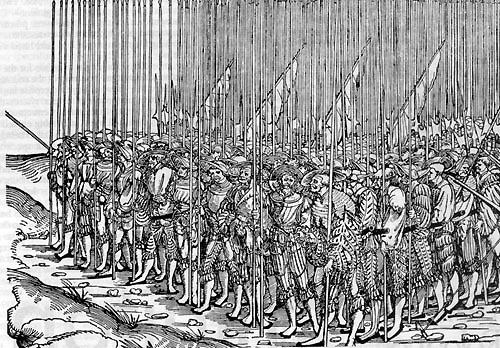LANDSKNECHT & REISLAUFER
BAD WAR

The Slaughter of Marignano [1515] by Urs Graf, a Swiss reisläufer who fought in the battle
BAD WAR - During their long fight for freedom from their Hapsburg overlords, the medieval Swiss discovered that their enemy's aristocratic, armoured horsemen were powerless against ordinary men on foot armed withpikes, halberds and two-handed swords. The noble knight encased in chain-mail or steel plates had been master of the battlefield for more than five hundred years but the success of the Swiss 'pike squares' won The Cantons more than freedom. For the next two centuries Swiss pikemen and halberdiers became much in demand as mercenaries and armies made up of these reisläufer were all but invincible. The supremacy of the Swiss would only be challenged by their German imitators - the landsknechts.
The Swiss defeat of a numerically superior imperial army at Dornach [1499] finally convinced the Hapsburg Holy Roman Emperor Maximilian I that the age of the armoured knight was over and he ordered his favourite captain, Georg Von Frundsberg, to create a new army to beat the Swiss at their own game.
As ordered, Frundsberg recruited men from Germany's Swabian heartlands and trained them to fight in the Swiss manner. Frundsberg's pike squares proved their worth in the wars to drive the French out of Northern Italy and the age of the landsknecht was born.For the next fifty years the flamboyantly dressed landsknechts were invincible on the battlefield until they in their turn were eclipsed by the Spanish version of the pike square the 'Tercio'.

Contemporary woodcut of a landsknecht pike square
Imitation may be the sincerest form of flattery but the Germans' slavish copying of Swiss weapons and tactics was not appreciated by their Alpine brothers-in-arms. Whenever landsknechts and reisläufers met, which was a frequent occurrence during the interminable Valois-Hapsburg Wars that devastated Italy and the Low Countries, they fought to the death.
Throughout the first half of the 16th Century, the fanatical devotion with which reisläufers and landsknechts' slaughtered each other, and their paymasters' enemies, earned these rapacious soldiers of fortune a reputation for savage ruthlessness that was the exact opposite of medieval chivalry. Such was the animosity between these rivals, their murderous battles even became known as schlechtekrieg... Bad War.

'Bad War' by Hans Holbein the Younger